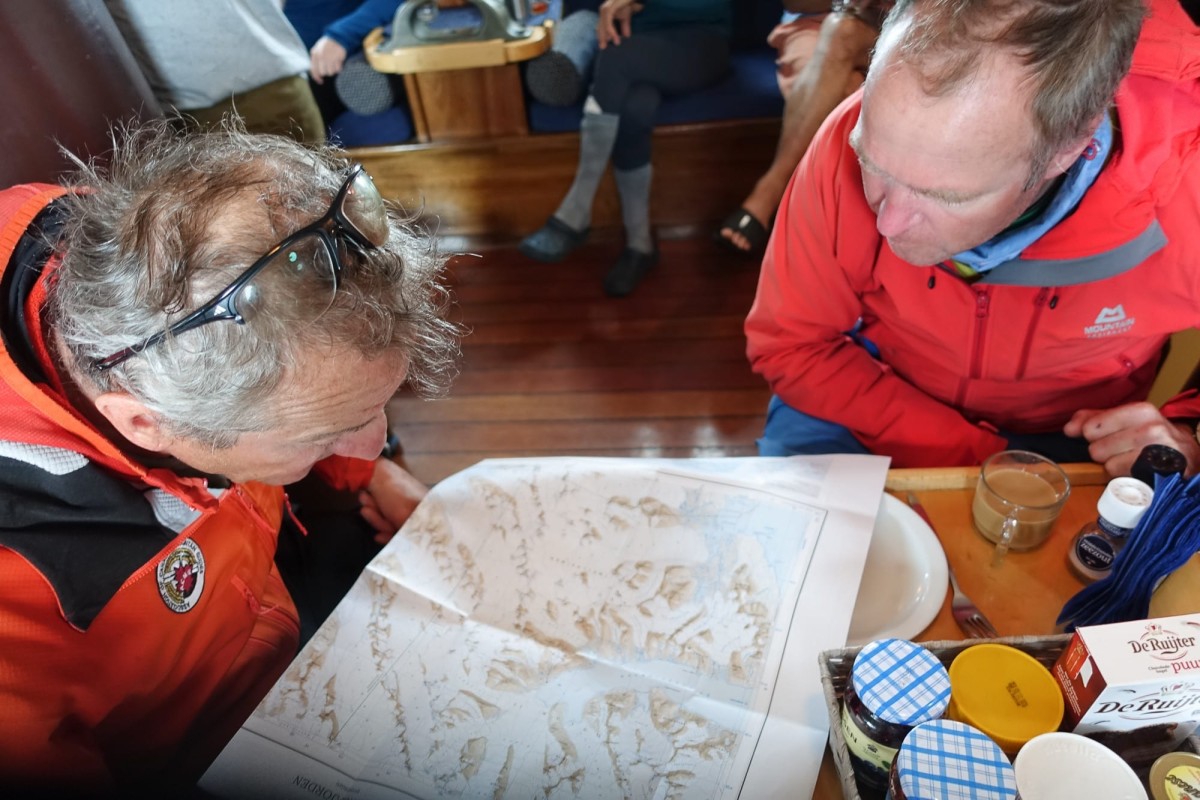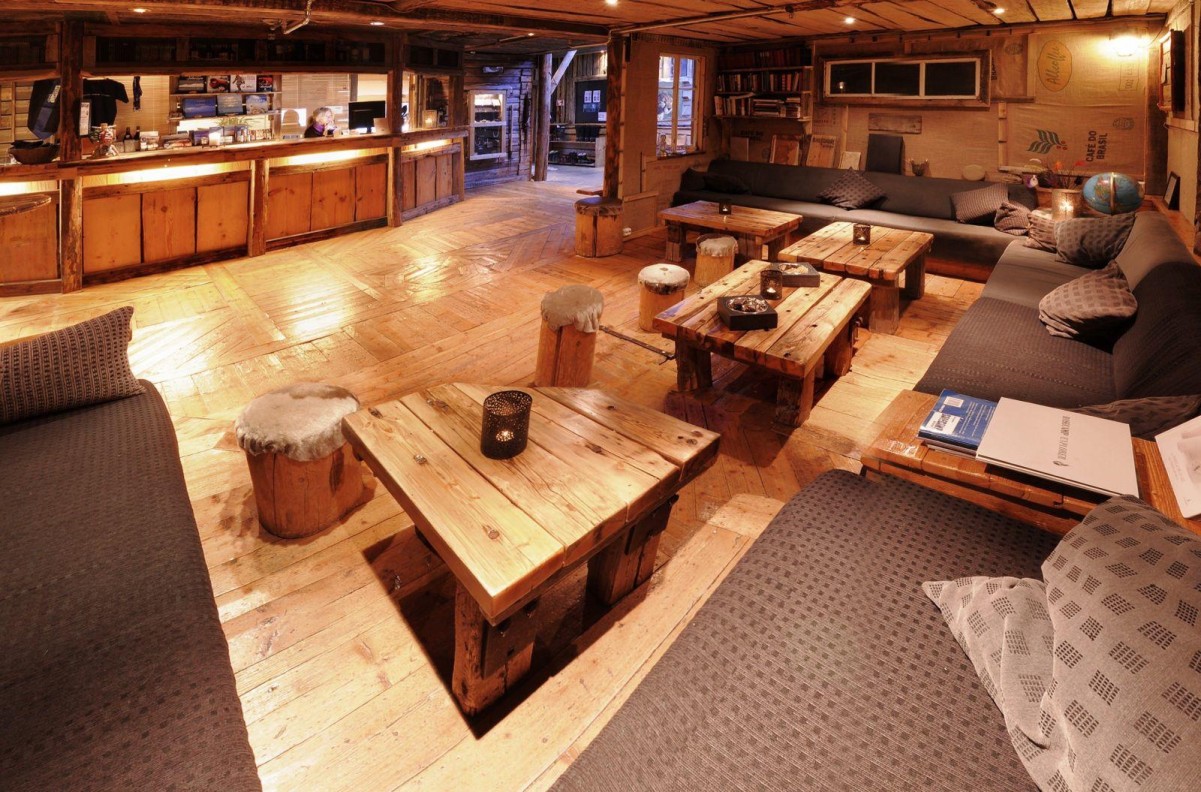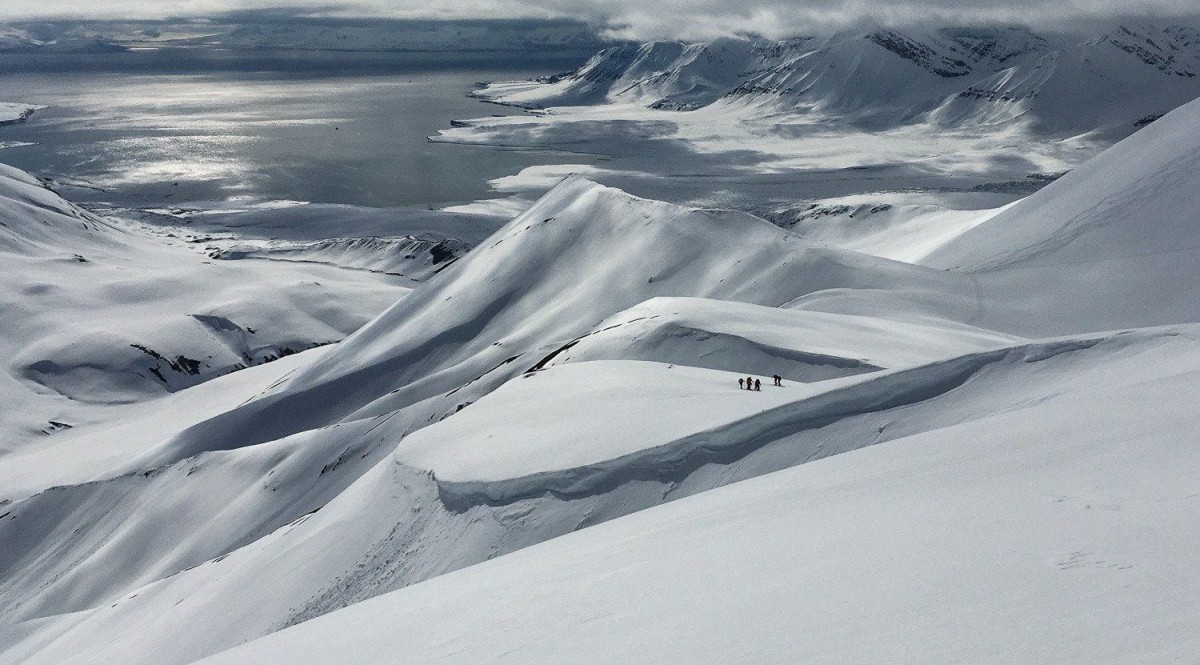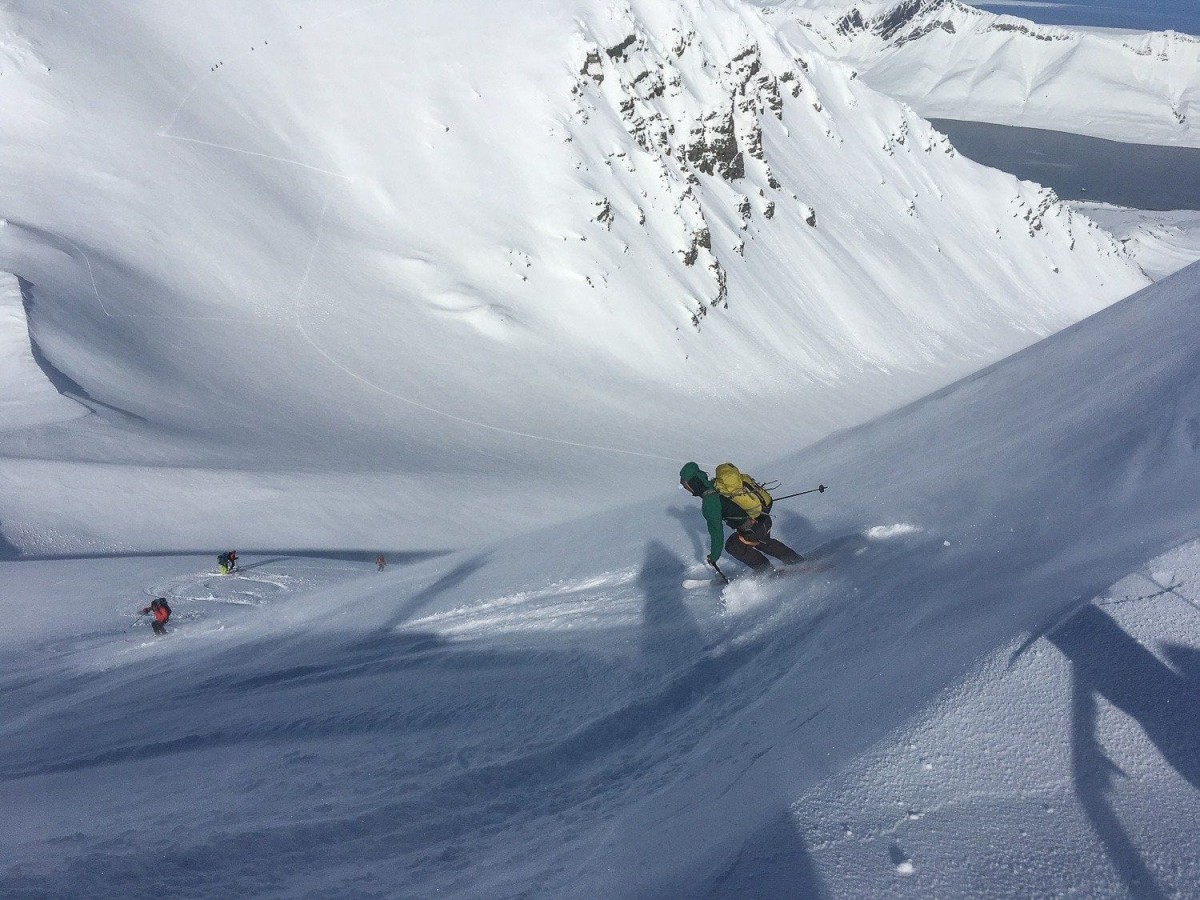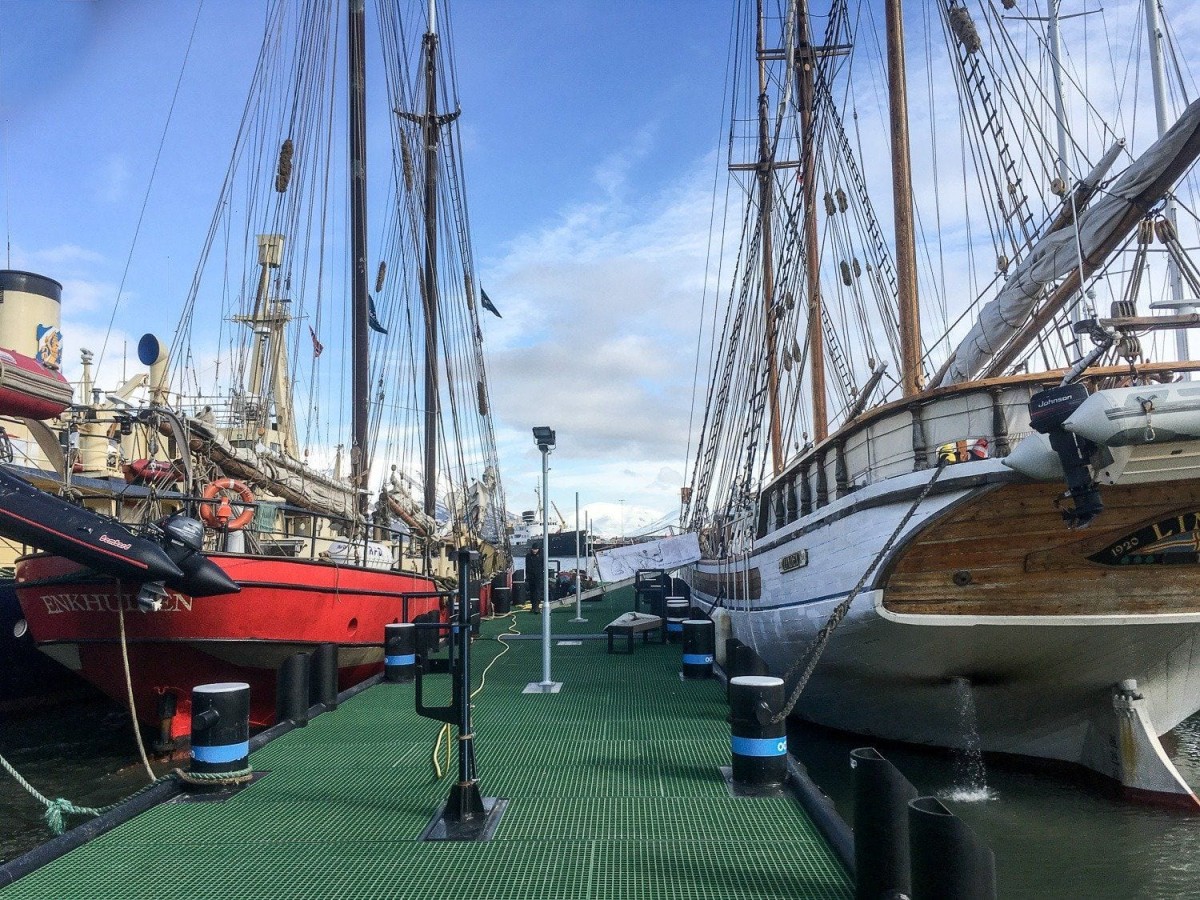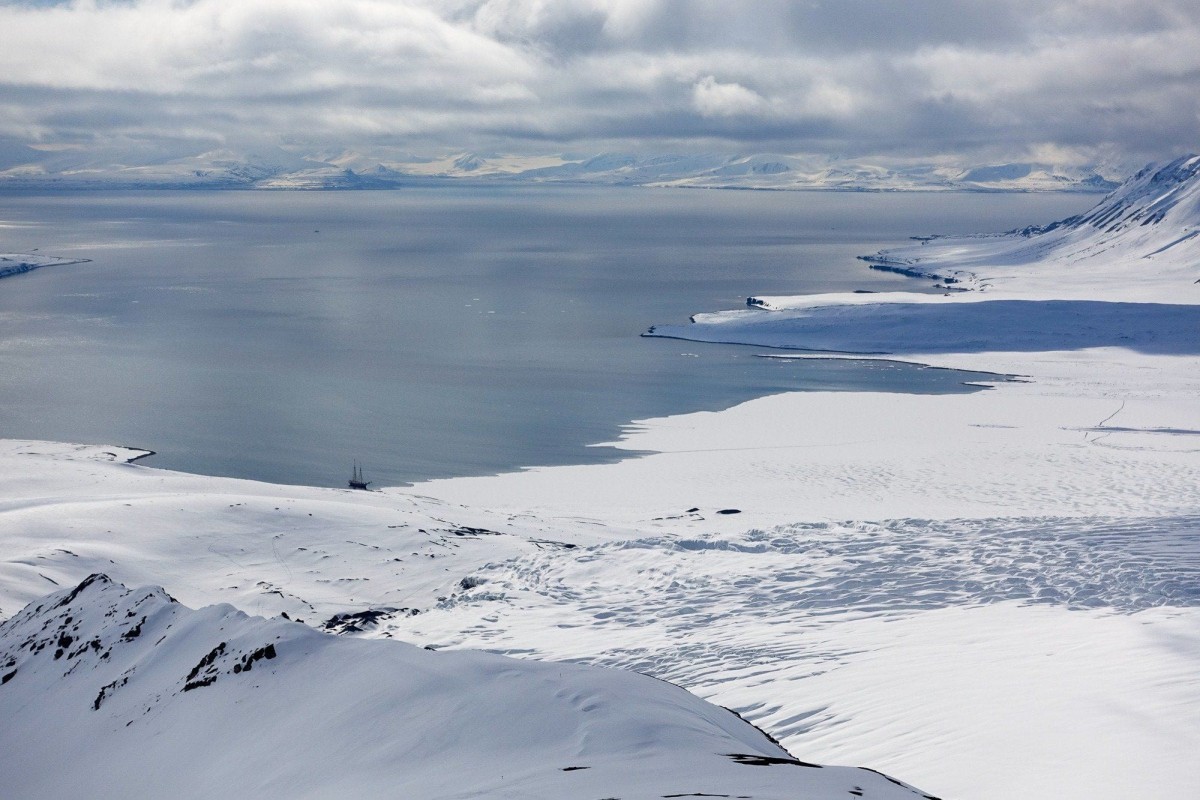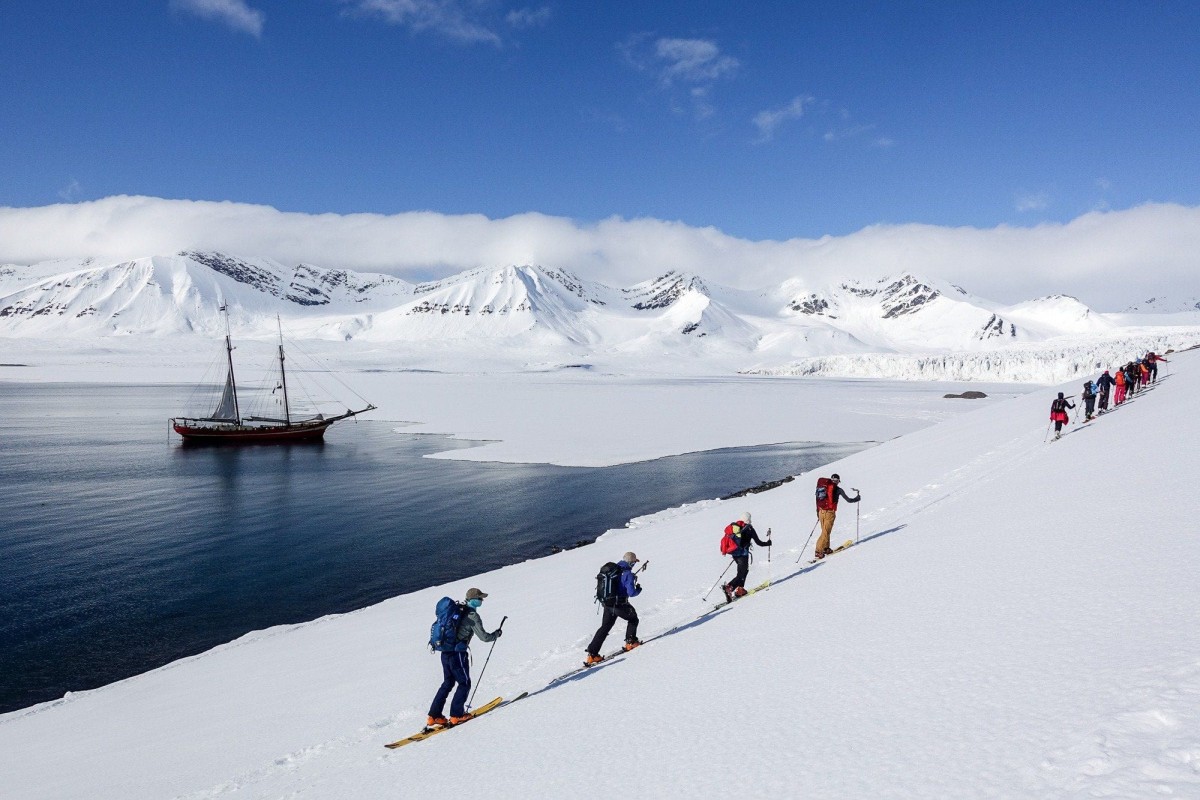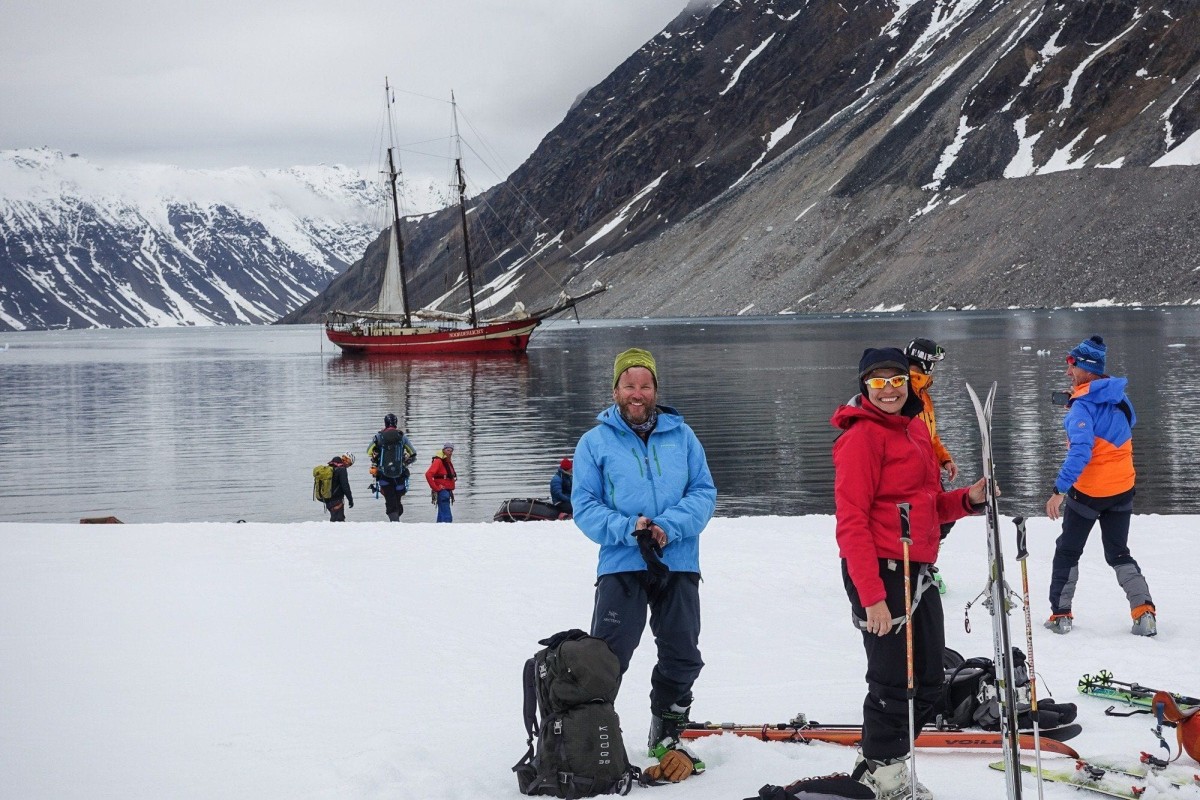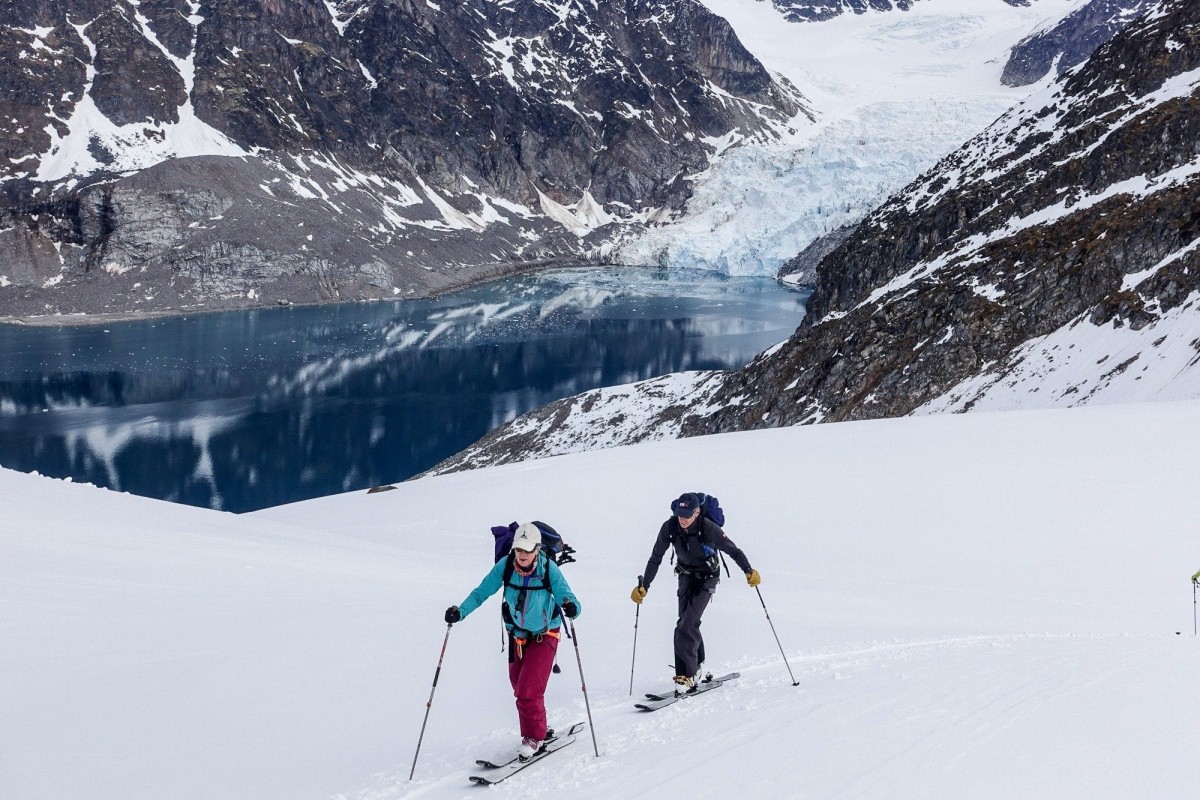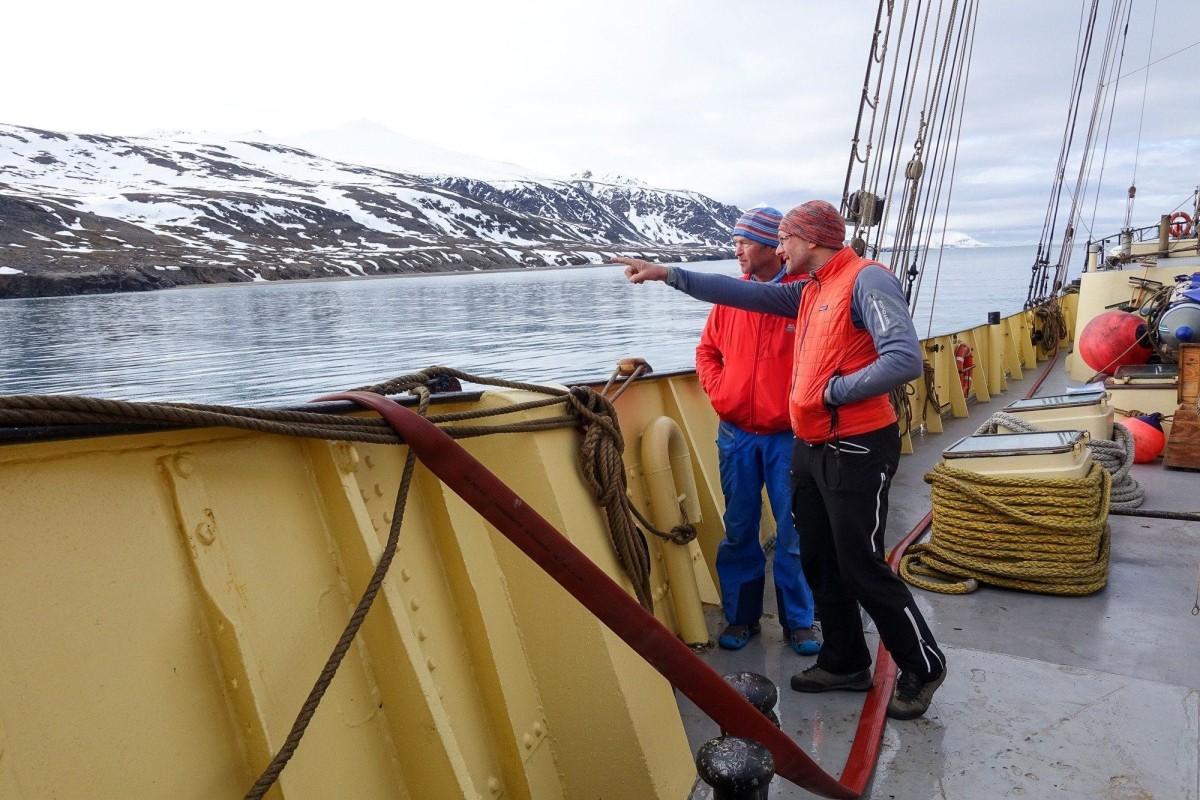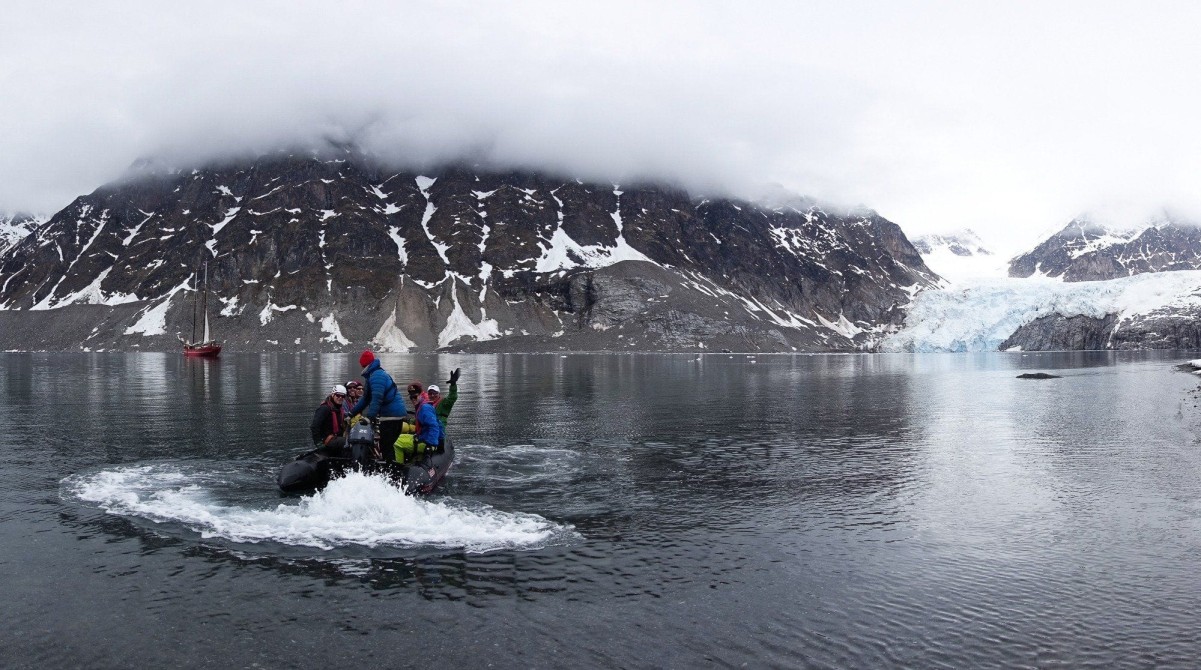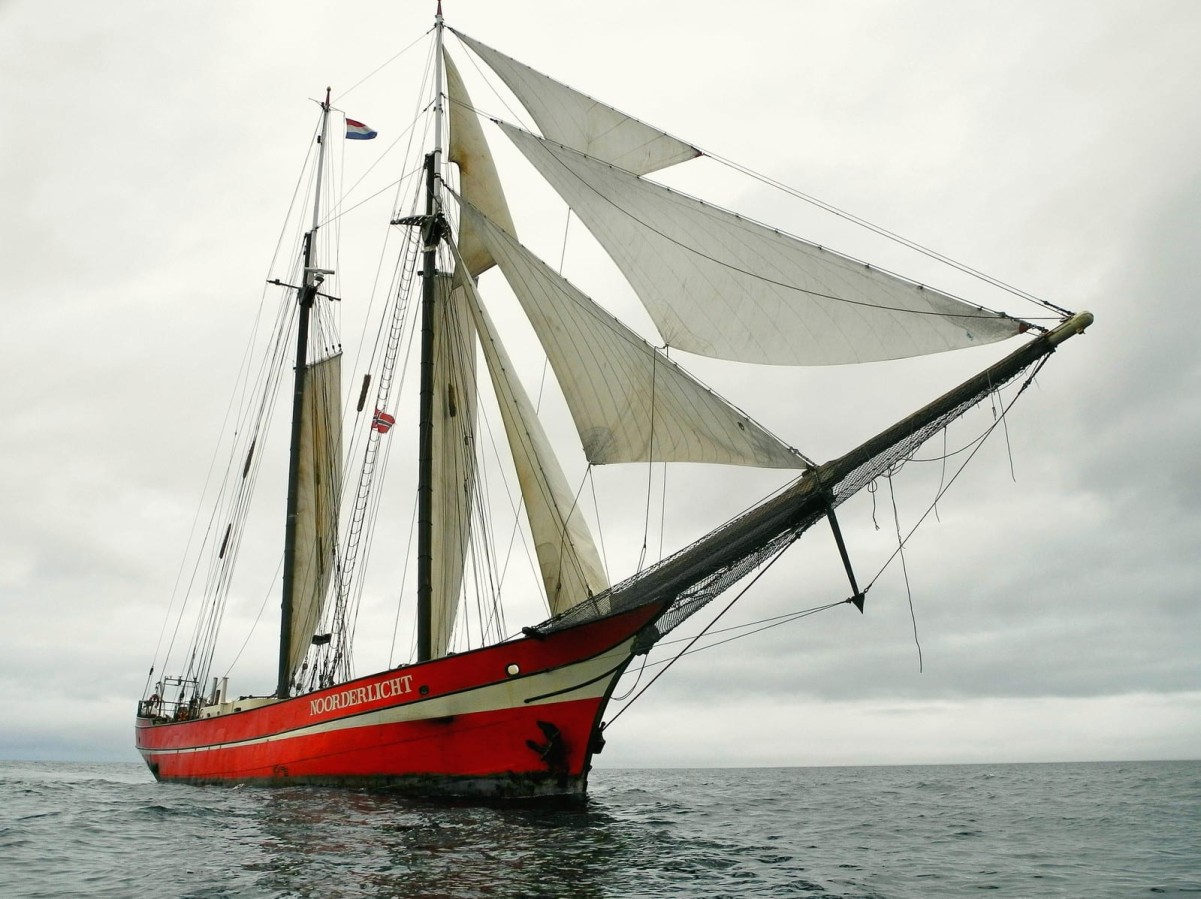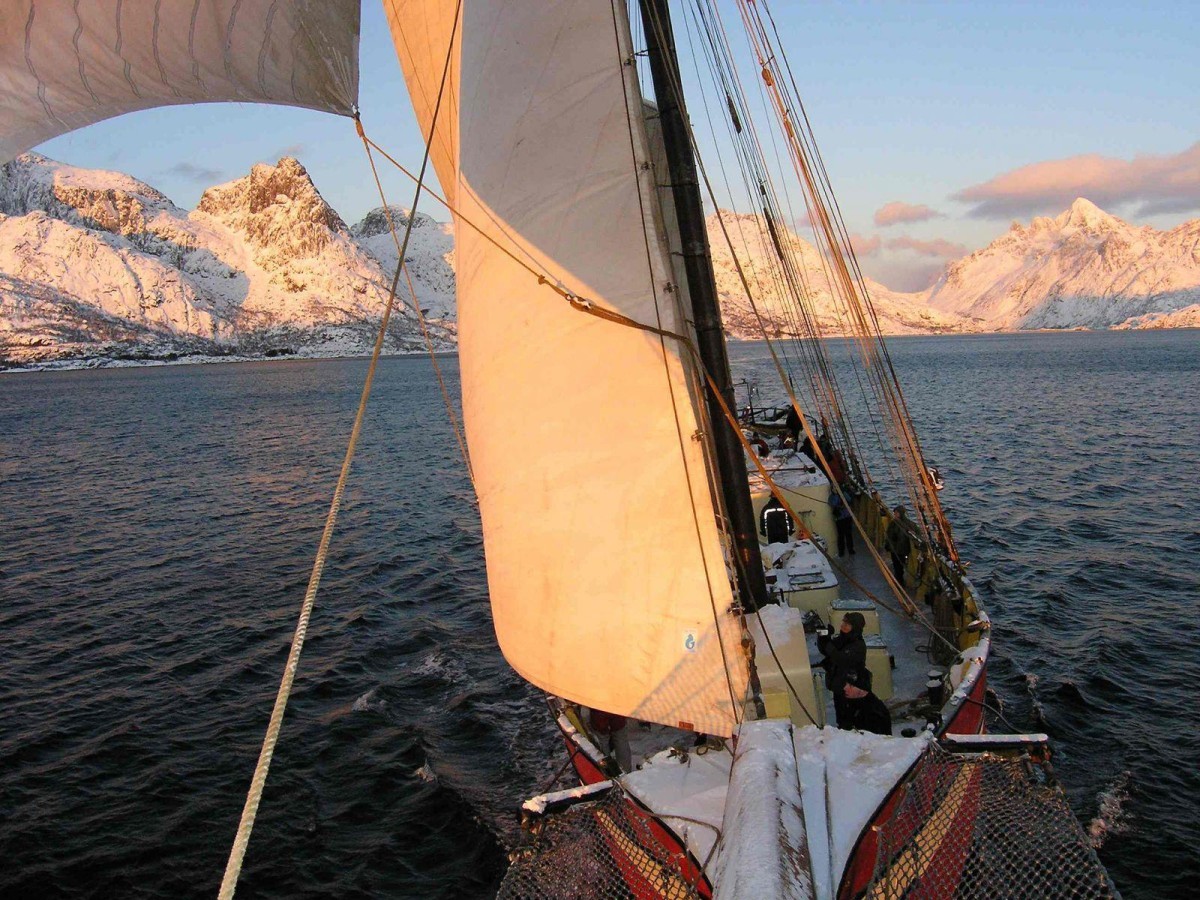Svalbard Ski & Sail
Explore the Fjords of Spitzbergen from a comfortable sailing vessel
2025 // APRIL 17-27 / APRIL 24-MAY 4 / MAY 1-11 / MAY 8-18 / MAY 15-25
2026 // NO & QL: APRIL 26-MAY 3 / MAY 3-10 / MAY 10-17 / MAY 17-24 / RVR: May 8-15
New for 2025: We are pleased to add s/y Qilak (QL) to our Svalbard Ski and Sail program!
Back for 2026: We are pleased to announce the return of the s/v Rembrandt van Rijn (RVR) to our Svalbard Ski and Sail program!
Backcountry ski touring and sailing expedition along the west coast of Spitsbergen, at about the midpoint between the northern coast of Norway and the North Pole. The Svalbard archipelago of over 60 mostly unpopulated islands is a wild and remote place, and at a latitude of greater than 78º it is level with Canada’s Ellesmere Island, or the northernmost end of Greenland. Our Ski and Sail expedition in Svalbard is a journey into one of the most unique and surreal ski touring destinations in the world with its juxtaposition of sea, mountain, and arctic environment. Yet, it is surprisingly easy to access, with three-times daily airline flights into the modern airport at Longyearbyen.
The west coast of Spitsbergen is protected by a long, thin island called Prins Karls Vorland, which protects an inner channel and allows straightforward sea access to dozens of fjords. The fjords harbour countless peaks rising 500 to 1000 m out of the sea, and offer outstanding ski touring opportunities. It is a land perfectly designed for skiing. Gaining access to these beautiful glaciated peaks is only possible by boat, as helicopter skiing is strictly forbidden in Svalbard. And a good thing, too: a sailing yacht is really the best way to visit this country, a tradition that has existed since whaling boats first made use of the area over 200 years ago.
Backcountry skiing – from a Sailboat!
For 2025 we are offering ski and sail trips on two comfortable and unique sailing vessels and in 2026 we will add a third. See “Our Ships” in the tabs below for a description of these amazing sailing vessels.
Ski the remote Fjords of Spitzbergen
Travel by boat enables us to sample the best ski touring and ski mountaineering spots along the fjords of the west coast of Spitzbergen, Svalbard’s largest island. Given the long days in spring, there will not be any rush: around the clock the midnight sun provides an amazing soft light that is unique to ski touring this far north. Our goal is to ski tour every day after lifting anchors in Longyearbyen. We access the skiing via a rubber dinghy powered by an outboard motor. We step off the dinghy, over the cold salty waters that lap at the narrow interface between sea and alpine, put on skis and packs, and climb!
Skiing days last from 5 – 9 hrs. Due to local regulations regarding polar bears, the guides will be carrying bear deterrents and firearms during the ski touring days.
Longyear City – Ski out of your hotel
For our guests who want to spend more time in this amazing area we offer an optional 3-day pre-sail trip extension to do backcountry ski tours and / or a snowmobile tour based in Svalbard’s main town, Longyearbyen.
Longyearbyen, with a population of about 2000, is the northernmost town in the world and is the staging point for our trip with its airport and harbour. Despite its remote location, Longyearbyen offers exceptional amenities. It has a quaint town center with bars, restaurants, shops and two arctic history museums. We will stay at Mary-Ann’s Polarrigg – a unique hotel, close to the harbour and with a remarkable ambience including a lush greenhouse restaurant complete with a stuffed polar bear. At this latitude, even in May, we can often count on being able to put our skis on right at the hotel at sea level and tour up into the mountains above town.

Trip reports, Photos and Maps
To get a better idea of what to expect from our Svalbard Ski and Sail ski trip, please check out our Svalbard photo album and Ski Touring in Svalbard blog post about our 2018 Ski & Sail adventure. A great resource is this topo map of Svalbard made available by the Norwegian Polar Institute. Finally, our 360° Virtual Tour is a great way to get a feel for what to expect when you step on board the s/v Noorderlicht.
DATES: 8-day trips (not including 3-day pre-sail option)
2025:
Noorderlicht and Qilak
NO25-A/QL25-1: Apr 20-27
NO25-0/QL25-2: Apr 27-May 4
NO25-1/QL25-3: May 4-11
NO25-2/QL25-4: May 11-18
NO25-3/QL25-5: May 18-25
2026:
Noorderlicht and Qilak
NO26-1/QL26-1: April 26-May 3
NO26-2/QL26-2: May 3-10
NO26-3/QL26-3: May 10-17
NO26-4/QL26-4: May 17-24
Rembrandt van Rijn
RVR26: May 8-15
PRICE:
2025 // NO & QL: €5995 for 8-day trip (6650 USD/ 8650 CAD)
2026 // NO & QL: €5995 for 8-day trip (6650 USD/ 8650 CAD), RVR: Starting at €6995 for 8-day trip (7750 USD / 9950 CAD / About £4,612)
OPTIONS: 3-day pre-sail trip in Longyearbyen (€1495 / 2190 CAD). Single occupancy hotel room (€365 / 550 CAD). Single occupancy boat (€2000 / 2990 CAD).
PAYMENT SCHEDULE: 30% payment secures your booking; 30% due September 1; 40% due February 1
SKI AND SAIL INCLUDES: 7 nights two mast sailboat rental with crew, harbour fees, permit fees, UIAGM / IFMGA mountain guides, full board.
PRESAIL INCLUDES: 3 additional days of town based ski tours out of Longyearbyen, 3 x Hotel B&B in Longyearbyen.
NOT INCLUDED: Air travel, alcoholic beverages, lunches and dinners in Longyearbyen, gratuities.
TOM WOLFE
Tom has been guiding since moving to Canmore in 1995, the place he calls home with wife, son and daughter. He guides year around, with winters being a mix of ski guiding at lodges, heli-ski operations, and remote backcountry destinations throughout western Canada and the arctic. Tom is the owner of Sawback Alpine Adventures. He speaks English, German, and enough French and Spanish to get by. Svalbard is one of Tom’s favourite places to ski. This spring he will have his hands full operating three back to back Ski & Sail trips. This spring Tom will guide on our NO24-1, NO24-2 and NO24-4 sailings.
CHRISTIAN SCHLUMPF
CONRAD JANZEN
Conrad started climbing and skiing in 1994 on a Yamnuska Mountain Adventures Semester in Canmore, Alberta. Following this he attended the University of Calgary, graduating with a Degree in Kinesiology and a Minor in Outdoor Pursuits in 1999.
Conrad has been guiding climbing, skiing and paddling trips since 1997 throughout the mountain regions of Alberta and British Columbia, into the Yukon and Northwest Territories, and occasionally guiding international trips as well.
In addition to setting up private guiding adventures for individuals and groups, Conrad has guided for a variety of outdoor companies including Canadian Mountain Holidays , Yamnuska Mountain Adventures, and the Alpine Club of Canada. He is also part of the Parks Canada Visitor Safety team in who create daily avalanche hazard bulletins, carry out highway avalanche control, and provide the mountain rescue services in Banff, Yoho and Kootenay National Parks.
Conrad is joining us on our NO24-1 and NO24-2 trips this season.
ANDREA FUSARI
I have always considered the mountains to be my true home, a place without boundaries where you can really 100% be yourself. After graduating in Environmental Science with specialisation in Snow Science, in 2014 I qualified as Aspirant Mountain Guide and, in 2017, as UIAGM Mountain Guide. Since then, I have devoted myself to my profession with passion and commitment. The most rewarding part of our job is to see the satisfaction and joy in the eyes of those who choose to rope up with us after a day in the mountains, whether it be on skis or in climbing shoes. It’s all about conveying our passion and teaching the skills that we need every day in the heart of the mountains. I consider mountaineering in all its forms to be an “excuse” to travel and discover different cultures, near and far, in the deep snow of Greenland or the rocky Berber valleys of the Moroccan Atlas Mountains. Andrea will join us in Svalbard for NO24-2 this season.
CHRISTOPH GNIESER
Pawel Kunachowicz
Pawel is an international certified IFMGA mountain guide and alpine ski instructor. For over 20 years he has worked as a professional in the mountains, first as a ski instructor, then also as a guide. Pawel lives in Chamonix and where he offers his guiding services all year round. In winter he skis off piste, guiding classic multiple day ski tours such as Haute Route from Chamonix to Zermatt or Spaghetti Tour around Monte Rosa massif. During summer Pawel guides Mont Blanc, Matterhorn and Eiger and other classic alpine routes.
Pawel’s favourite mountain adventure memories are skiing off Denali peak in Alaska, Mustagh Ata in China (7546 m), a ski traverse in Svalbard, heliskiing in Verbier in Switzerland, climbing in Peru, India, Yosemite National Park and in Chamonix, as well as taking part in UTMB ultra marathon.
Pawel will join us for NO24-3 this season!
Itinerary
We meet in Longyearbyen on the first day of the trip at Mary Ann’s Polarrigg. There will be a group meeting at 16:00 to discuss the next day’s tour. You can arrive as late as the afternoon of Day 4; note that embarkation is at 16:00. We will be done with the trip on the morning of the last day, which is Day 11, disembarking at 09:00.
Day 1: Arrival at the airport in Longyearbyen from Oslo (with SAS or Norwegian Airlines) in the early afternoon (usually one overnight required in Oslo). Transfer to our Hotel and time to check out the town including a visit to the “Polarmuseum”.
Day 2-3: Ski touring day trips close to town and return to our hotel
Day 4: Potentially another shorter ski touring trip from town or a visit to an ice cave (4 hrs). Arrival day for those participants who chose to participate in the boat trip only. Embarkation is at 16:00, followed by a quick safety briefing. Departure from pier usually around 17:00.
Day 5 – 10:
We usually only sail one hour to our first ski tour in the Isfjord; harbours like Ymerbukta or Tryghamna. From there, we continue to sail along the West Coast of Spitzbergen to sample the best ski touring and peak ascent the group of islands has to offer. In May and June the sun will be with us for 24 hours in Svalbard, which leaves a lot of flexibility for our departures. After each day of skiing we return from the shoreline by Zodiak motor boat back to our Yacht, where the smell of dinner will usually welcome us. We usually finish the day on deck with a glass of wine, enjoying the contrast of the sea and the magnificent mountainscape with the everlasting sun above the horizon.
Arrival back in Longyearbyen usually around 4 PM. Farewell dinner on the boat.
Day 11: We bid farewell to our yacht and crew in the morning. Disemarkation is after a final breakfast onboard, at 09:00 after settling bar tabs and gratuities. You will need to arrange transfers to a hotel or to the airport, depending on your destination post-trip, by taxi or bus.
Svalbard Ski and Sail Logistics
This year’s Svalbard Ski and Sail trip starts in Longyearbyen on Svalbard. There are usually multiple daily flights between Longyearbyen and Oslo, Norway.
If you choose to only participate in the boat portion of this trip, you must arrive in Longyearbyen at the latest on Day 4 (see Itinerary tab). We will be boarding the boat at around 4:00 pm. Unfortunately in 2023 both airlines servicing Longyearbyen chose to cancel flights on Saturdays, which requires booking a hotel room for an extra night. This last night accommodation is not included in your trip fees, as it was unanticipated when we scheduled our 2023 trips. We recommend Mary-Ann’s Polarrigg, Basecamp Spitzbergen or Gjestehuset 102 as great options for that last night.
There is an optional 3 days of ski touring offered (see above Itinerary tab for dates). If you arrive in Longyearbyen on Day 1 then you can participate in all three pre-sail ski tours, but you can also arrive later than that if you like. Please advise us of your intentions so we can make hotel bookings and other arrangements.
When you book your return flight, the best option is to book a flight (even a very early one) from Longyearbyen on the last day (see Itinerary tab)
AiRport Hotel Transfers
Covid information
Please consult our up-to-date Covid Response Info page for details on travel to Norway and Svalbard during covid. Scroll to near the bottom for specifics.
Booking your flights & Oslo hotel
There’s no fast way to get to Svalbard. That said, I do have some hard won advice.
First of all, please bring your boots as carry-on. Do not put them in your checked baggage. Many things can be purchased or rented in the case of lost baggage but not boots. We also suggest you bring your sk touring pack with a set of clothing and transceiver (check your shovel and probe as these are things that can be loaned to you easily).
Finding a good deal on a good flight itinerary to Longyearbyen takes a bit of work. Book well in advance of your trip. Be careful of using the discount sites as additional luggage fees — charged for each leg of your trip potentially — can be pretty hefty. You will need two 23-kg bags so factor that into your planning.
Look for and spend a bit of extra money if necessary to get flights with shorter (<4 hr) stopovers and as few connections as possible.
For your flight to Oslo, look for flights with shorter durations and the fewest connections. Direct flights to Oslo from North America are only available from New York City, Miami and Los Angeles (see this webpage for a comprehensive list of direct international flights to Oslo).
I recommend you use one of the big airlines like KLM/Delta or Lufthansa/Air Canada all the way to Oslo, aiming to arrive in Oslo in the early afternoon. Remember to account for baggage costs. SAS offers direct flights from a couple of US hubs (I believe Newark and Denver) to Iceland Air offers a slightly different schedule and is worth checking out — not to mention they allow a “free” multi-day “stopover” option for those thinking of checking out Iceland as part of this trip!
If you want a budget option from the USA then you might consider Norse Atlantic Airways — I don’t have any experience with this small airline so buyer beware. But they do advertise some attractive deals: $119 USD one way JFK-OSL, or a $169 direct flight from LAX-OSL! The most amazing thing about this airline is flights that leave Oslo mid-afternoon, which means it’s technically possible to make it back from Longyearbyen to Los Angeles in a single day (however, flights are not every day and probably won’t line up perfectly with our trip dates).
From Oslo you will almost certainly need to overnight and catch the next morning’s flight to Longyearbyen (with SAS or Norwegian airlines), unless perhaps your previous flight was very early in the day (from within Europe).
At the Oslo Airport (Gardermoen) my recommendation is the Radisson Hotel & Conference Centre Oslo Airport ($$$). It’s very comfortable and has the best Norwegian-style breakfast buffet — definitely get the “with breakfast” option! It is a short walk from the airport (turn left out of arrivals and walk about 400 m; you can bring a luggage cart with you). It’s very comfortable, and my recommendation for efficiency. I do not recommend booking with a third party agency for the Radisson as making changes will be more complicated and booking directly with the hotel also ensures the best rate (lowest rate is guaranteed).
If you want something a bit cheaper and close to the airport there’s the Scandic Gardermoen ($$). It’s a 7 minute cab or shuttle drive away, which adds to the cost and complication factor. The shuttle service stops at Oslo Airport are on the lower level of Oslo Airport – platform 39. Vy shuttle S55 runs every 15 minutes weekdays from kl. 04.35 – 10.20 and 14.20 – 17:20. Saturday and Sunday every 30 minutes from kl. 04.35 to 01.05 (last departure from the airport). Cost is 80 NOK.
Oslo is a great world class city to visit. There are also good, interesting hotels in downtown Oslo if you want to spend a night or a few days there before or after the trip. I recommend storing your bulky gear at the Gardermoen airport (See Avinor Baggage Check for details & pricing) and taking the train into town with a light overnight bag. Here are a few to consider:
Hotel Continental Oslo – Owned by the same family for four generations, Continental is the only Norwegian member of “Leading Hotels of the World”. The hotel is home to the renowned restaurants Eik Annen Etage and Theatercafeen, and BAR BOMAN, a lobby bar with Munch’s art on the walls. $$$
Scandic Victoria – Central hotel in Oslo, only a short walk from Karl Johans gate, Stortinget parliament and Spikersuppa ice skating rink. Vibrant Aker Brygge and Tjuvholmen are only a 5 minute walk from the hotel, with many trendy bars and restaurants right on the waterfront of Oslo. Akershus Fortress is also within walking distance. $$
Comfort Hotel Grand Central – The Comfort Hotel Grand Central is one of Oslo’s most centrally-located hotels and is found in the main train station, just a 30-minute transfer from Oslo airport. $
Hotel Rosencrantz – Design hotel in the centre of Oslo, just around the corner from Karl Johans gate, public transport and many of the city’s biggest attractions. $$
On the way back, book a flight on the morning of Day 11 (see Itinerary tab for dates) to Oslo. If you are heading to a European city as your final destination you should be able to continue on same day. If you are heading across the Atlantic, plan to stay in Oslo again that night and catch an early flight back home, again with one of the big airlines.
What to do in Oslo
If you spend a few days in Oslo there’s lots to do. Take the train (there are two companies; vy.no is the one to use) to the main station and walk around the town. Be sure to check out the habourfront which has lots of nice restaurants and things to see. Here’s a great post-arrival itinerary:
- Book into your airport hotel and have a quick shower. Radisson Hotel & Conference & Red are the nicest but 500 m from the airport, Radisson Blue is right next to the train station and airport. You can store most of your stuff in a storage room at the checkin, so make sure you have a small pack with your essentials for an overnight stay (clothes, toiletries etc). Don’t take a nap!
- Take the train to the Oslo Central Station. Vy and Flytoget are the two train options, with Vy being a lot cheaper and only a few minutes slower. See this how-to for details.
- Check out the sauna on the harbourfront: Oslo Badstuforening or Pust Sauna. Don’t forget towels and bathing suit.
- Then check out one of the great restaurants with patios with harbour views, such as Seaport Restaurant. Plenty of options to choose from!
- Take the train back to your hotel and around 9 or 10 pm go to sleep. Maybe take a Melatonin tablet to help with jetlag!
Here are some other ideas:
Oslo Opera House – a great place to walk and a nice view from the rooftop.
Kon-ti-ki Museum – Thor Heyerdahl is one of history’s most famous explorers. In 1947 he crossed the Pacific Ocean on the balsawood raft Kon-Tiki. This was his first expedition to be captured on film, and was later awarded Academy Award for best documentary in 1951. He later completed similar achievements with the reed boats Ra, Ra II and Tigris, through which he championed his deep involvement for both the environment and world peace. He was also responsible for important archeological excavations on the Galapagos Islands, Easter Island and in Túcume. The Kon-Tiki Museum exhibits objects from Heyerdahl’s world famous expeditions, the original Kon-Tiki raft, and the papyrus boat Ra II.
Fram Museum – Polar Expedition Museum. Being the most famous wooden polar vessel in the world, Fram is a symbol of Norway’s significant participation in the heroic age of exploration.
Eating in Oslo and Svalbard
Here are a collection of tips for eating in Norway & Svalbard.
OSL – cheap eats
If you need a fast bite to eat before heading to your hotel, “cheap” pizza is the way to go, located at airport arrivals level. Peppe’s Pizza, grab it before you leave! Large pizza about 300 NOK ($42 CAD). OK, not cheap — welcome to Norway! Despite the mixed Tripadvisor reviews, Peppes is “Good enough” after a long flight. Get the 1, 2 or 3 slice deal with a soda and you won’t go hungry.
LYR – restaurants: best to book ahead with large groups.
Great little restaurant adjoining Basecamp Spitsberten Hotel has a beautiful round table perfect for group dinners. Burgers, pizza, etc (Restaurant Kroa) $-$$
Vinterhagen, which adjoins Mary-Ann’s Polarrigg Hotel, is in a greenhouse full of tropical plants — a unique place to experience arctic vistas simultaneously — and serves arctic fare such as seal, char and reindeer $$-$$$.
Baretnz Gastropub (located in the Radisson) has best pizza and beer pub in town and a nice atmosphere (very crowded on weekends). $-$$
Pub next door to Basecamp across from the parking lot (Svalbar Pub) has good food and prices $-$$
Svalbard Brewery claims to be the world’s northernmost brewery and is down by the ocean, not too long of a walk, worth getting a reservation for a tour and tasting one night. 429 NOK pp for 5 samples, minimum 4 persons, Fridays 16:00, 18:00 and 20:00 only $$$.
Coal Miner’s Bar and Grill is good $-$$
Sushi on Svalbard? Why not? Svalbard has always been multi-ethnic, with no aboriginal population, and it’s an ocean town so it should come as no suprise that they have an excellent, authentic Tokyo-style sushi joint: NUGA $
Stationen is a pub-style restaurant with a great menu. Try the beef tagliata for one of the best budget meals in town $$
For a special high end expensive dinner try Polfareren which is close to Basecamp. Expensive and small portions but classy. Eat something before you go, or hit the Svalbar afterwards of pizza if you have a big appetite 🙂 $$$-$$$$
My favourite restaurant of all time is the Gruvelageret which is located about 3 km from town $$$-$$$$
A few web resources
Images from the Noorderlicht Sailing Yacht
Svalbard Topo Map – Check out the amazing archipelago of Svalbard with this excellent online topo map. See the terrain that makes our Svalbard Ski and Sail so incredible.
Polarmuseum website – Everyone who visits Longyearbyen has to check this place out. The North Pole museum is old and run down and not very good but still probably worth a visit.
Photo album from our May 2018 trip – A collection of my best photos from this year’s trip
Blog post from our 2018 trip – A little blog post I wrote about the trip.
Norwegian Airlines – Norway’s “budget” airline that somehow also manages to offer world class service and free WiFi internet!
SAS Airlines – Scandinavian codeshares with United, Air Canada, Lufthansa, etc. for seamless itineraries.
Iceland Air – offers “free” stopovers in Iceland with flights between North America and Europe, as well as a slightly different time schedule that might work better for you than United / AC / Lufthansa connections.
Svalbard Equipment list
Packing Notes
Boots: if you carry anything onto the airplane on your way to Norway make it your boots. Many other items can be replaced at the last minute, but not boots.
Ski crampons are a must for spring ski touring on Svalbard. They are specific to your binding type. Order well in advance as this is something that’s often not available at the last minute. If you can’t find a crampon to fit your binding, G3 crampons have an attachment system that works for many bindings. Again, do this well in advance of the trip.
There are currently limited ski touring rentals on Svalbard but no boot rentals are available. Contact Sportcenteret well in advance to arrange for rentals. Please be aware of the risks of counting on rental gear being available in this remote Arctic location. Sawback does rent ski gear with advanced notice. If you need to rent from us the fee is $550 CAD for this trip, and you must sign a rental waiver. In any event it is highly recommended you bring your own equipment and that you make sure it is in top condition. The Greenland sea is not a great place to go shopping for new gear after breaking your ski in half!
Norwegian Kroner — please do not bother exchanging for Norwegian cash (krone aka NOK). You will be very hard pressed to figure out a way to spend it on Svalbard as no merchants (except for one) want it and accept only cards. If you give it staff or crew as a tip at the end of the week (after you realized you didn’t have any way to spend it) then you’ve left them with the same problem. Canadian guides prefer tips in CAD, USD or EUR; American guides are happy with USD or EUR; Euro guides and ship’s crew strongly prefer EUR over any other currency.
You need to bring all of the following personal equipment. Please don’t bring extra equipment as storage space on the boat, and especially in the cabins, is very limited. If you have any questions at all about gear please do not hesitate to contact us.
Clothing
There are no laundry facilities available on the Noorderlicht so please bring enough clothing to last the week.
- Wool or synthetic socks and liner socks
- Long underwear top – synthetic or wool
- Light fleece or wool sweater
- Wind shell – nylon or ‘Schoeller’ type jacket
- Waterproof breathable jacket
- Warm insulated jacket – down or synthetic
- Long underwear bottoms – synthetic or wool
- Multipurpose stretch nylon or ‘Schoeller’ type pants
- Waterproof breathable pants
- Warm hat – wool or synthetic
- Brimmed cap for sun protection
- Face warmer – scarf, neck tube or balaclava (optional)
- Light gloves – wool, synthetic or leather
- Insulated gloves or mitts with waterproof outer shell
- Spare gloves or mitts
- Handkerchief for blocking the sun (optional)
Snow Safety Equipment
- Avalanche beacon with good batteries (and spares)
- Shovel
- Probe (2.4m or longer preferred)
Travel Equipment
- Skis or split board
- Ski strap
- Ski or snowboard boots
- Poles
- Climbing skins
- Skin wax (or a simple wax candle) — pre-treat your skins ahead of time and bring extra skin wax. Spray-on wax or liquid wax (non-fluro!!) is a great idea too for field treatments.
- Ski crampons (mandatory)
- Boot crampons and lightweight ice axe (optional; don’t bring these if you don’t have them or don’t like steep skiing)
- Binding repair kit to fix your personal travel setup
- Ski helmet
- Ski scraper
Personal Equipment
- Ski pack (30-40 litres)
- Sunglasses (both orange and dark lenses help a lot for travel in all conditions)
- Goggles (orange lenses)
- Sunscreen and lip cream (SPF 30+)
- Head lamp with good batteries
- Insulated water bottle or thermos (1-2 L)
- Lunch bag or container
- Personal blister kit (i.e: Leukotape-P and Compeed, blister pads). Be sure to pre-tape problem spots on your feet with Leukotape, prevention is the best medicine!
- Tincture of Benzoin (see this how-to for an explanation) or a medical product by 3M called Cavilon — these products help the Leukotape stick for the whole week if necessary.
- Pocket knife (optional)
- Camera (optional)
- Binoculars (optional)
- Utility cord for hanging stuff to dry (very hepful for hanging personal items in your cabin)
Glacier Gear
- Harness – fitted for over your ski clothing
- Locking carabiners (x2)
- Non-locking carabiners (x2)
- Prussik cord – 5m x 6mm (optional)
- Sewn sling – 120cm (optional)
On the Sailing Boat & at the Hotel
- Small soft-sided duffle bag (30-50 L) to contain your clothes in your berth
- Shoes
- Winter boots for wearing around town
- Micro-spikes — especially the early season (late April / early May) trips as melt-freeze cycles can create very slippery conditions in the town
- Slippers
- High rubber boots for entering/exiting the dinghy (optional; the vast majority of exits/entries do not require this and we can always get by without)
- Comfortable clothing
- Personal medications and toiletries (including small-sized soap and shampoo)
- Ear plugs
- Reading material
- Chargers & adapters for electronic devices (normal AC power is available as 220V Euro plug)
- Cash in Euros to pay for your beer tab, souvenirs, and tips/gratuities (for both hotel and boat crew)
Note the following are provided:
- Beer and wine are available to purchase on the boat at a reasonable price. If you choose to bring your own you must declare it to the crew when you board. A corkage fee will apply (approx. 15 EUR per bottle of wine for reference). Please do not bring any hard alcohol and be modest with quantities — this is an expedition, not a party, with crew who work hard and keep long hours.
- Pillows, duvets, bed linen and towels supplied on the boat (& hotel)
Group Gear (supplied by the guides)
- Altimeter
- Map and compass
- GPS
- Snow study kit
- Snow and/or bush saw
- First aid kit
- Emergency tarp
- Emergency toboggan
- Group repair kit
- Radio & satellite communications devices
- Ropes for glacier travel
booking
Our Booking Form takes a few seconds to complete. We will then contact you to discuss your trip and answer any questions you might have. This is your opportunity to figure out for sure if this trip is for you, without obligation. To secure your booking you must complete our Online Waiver and Application Forms and pay your deposit.
Final payment is due 3 months in advance of your trip start date unless otherwise indicated. Please note that deposits are absolutely non-refundable, and final payments are non-refundable after the final payment date.
Paying
All of our trips are priced in Canadian Dollars. The approximate exchange rate is given for your convenience on each trip information page.
Foreign clients (and Canadian clients paying with a credit card): You will receive your invoice via Flywire, our online payment and foreign exchange service, after we review your booking application. You will be given various options of payment by credit card or bank transfer. For foreign clients, the exact rates you will be charged will be listed in the currency of the country you indicate to Flywire. These rates are competitive and offer good value compared with other options like bank transfers. There is no additional fee for credit card payments as this is wrapped into the rate offered (hence the higher cost of credit card payments).
Canadian clients paying by E-transfer: You will be invoiced via our accounting system Quickbooks. Please send an E-transfer to billing@sawback.com. If you prefer to pay by credit card in CAD indicate this on your Application Form. We charge a 3% processing fee for CAD card payments.
Booking Conditions Fine Print
READ CAREFULLY – BOOKING, RESERVATION, DEPOSIT: A deposit of 50% of the total price or private guiding fee is due with your booking unless otherwise indicated. You are required to complete our waiver and application forms during the booking process. You will be sent an invoice via our invoicing system, Flywire which provides all payment options available except Interac e-transfers. Flywire also provides foreign currency rates for the various payment options so you can pay in your local currency. If you wish to pay in CAD by E-transfer send funds to billing@sawback.com. Final payments are due 90 days before your trip starts. CONFIRMATION / TRIP INFORMATION: Upon receipt of this registration form we confirm your booking and you agree to pay your deposit within 7 days. Each trip we offer has a detailed trip information page (available on our website) with the trip details, equipment list, proposed itinerary and logistics, etc. Read through this carefully before completing your registration. TRIP (CANCELLATION / MEDICAL / EVACUATION / THEFT) INSURANCE: Once you complete your registration, we enter into financial obligations on our side and we cannot refund payments or release you from your contractual obligations. Therefore, we highly recommend buying cancellation insurance to cover your losses for the case that you can’t participate or have to interrupt your trip “for any reason”. Also, all participants need to have internationally accepted health insurance for all activities pertaining to the trip, including coverage for emergency rescue and evacuation. If you already have insurance, please make sure that you will be covered for “roped travel” booking a technical trip including “Via Ferrata” trips. We will gladly refer you to a travel insurance provider who offers “adventure travel insurance packages” and with whom our clients have had positive claims experiences in the past. Generally, you will receive the best benefits if you buy your insurance within 10 days of our booking confirmation. We strongly urge you to read our Insurance Information page carefully before booking your trip. CANCELLATIONS AND OVERDUE PAYMENTS: If you need to make a late payment or cancel a booking, please do so in writing (best by e-mail). Please note carefully the payment schedule for your trip. If you are overdue on a payment we reserve the right to cancel your booking without notice. At our sole discretion we may offer to credit you your deposit, less an administrative fee, towards a future trip. Cash refunds are not possible under any circumstance. CANCELLED PROGRAMS: Once we confirm your booking, we guarantee your trip departure. However, we do reserve the right to change guides, particular lodging or the itinerary or venue, should unforeseen circumstances (guide sickness, hut or route closing etc.) force us to do so or should the physical condition of the participants (see below), weather or mountain conditions, make a continuation as planned too risky. We will not be deemed to be in default for any delay or failure to perform our obligations under this Agreement resulting from acts of God, the elements, war, acts of government, civil or military authorities, natural calamities, catastrophe, fire, flood, accidents, epidemics, shortage of transportation, or any other like events beyond our reasonable control. PERSONAL FITNESS and GROUP TRAVEL: Our programs rely heavily on the integrity of each individual to assess his or her skill level and physical condition accurately. It is the responsibility of each participant to be aware of the necessary skill and fitness level for a particular trip. When in doubt, please call and discuss this with us! For the protection of yourself and other group members, we reserve the right to deny participation to any unprepared participant at any time of the trip, in which case we cannot offer a refund! In order to accommodate diverse levels of ability and ambition as well as diverse personalities, the decision making of the guide has to be geared towards safety and finding a consensus within the whole group, which may not please each individual participant at all times. Clients who are not willing to fit in with a diverse group and/or have less flexible goals are urged to make a private booking.
We have chartered two sailing vessels for 2025. Good old s/v Noorderlicht (NO) will be with us for yet another season. The Noorderlicht has proven to be an ideal vessel for a ski and sail trip. She is 50 m (150 ft) long and has a capacity for 12 passengers and 7 crew. Not too big but also not too small either. Spending a week on a boat it’s nice to have lots of room to move around and a variety of friends to mingle with throughout the week. A captain, second mate, third mate, cook and expedition coordinator are Swan Expedition’s staff who will ensure a successful and safe voyage. Built in 1910 she is older than the Titanic, and evidently a lot tougher too! New for 2025 is a reduced passenger capacity, a result of new regulations by the Norwegian government. Chris Gnieser will be Expedition Leader on Noorderlicht for the 2025 season. Click here for more information about Noorderlicht from the owner’s website.
The s/y Qilak (NO) is the latest addition to our Svalbard ski and sail program. After a successful pilot expedition with Qilak in Northern Norway in 2023 we are excited to be back on this beautiful yacht for 2025. At just over 20 m (67 ft) Qilak has been turning heads for completely different reasons. The 66ft/20.07m Qilak – her name is Inuit for the sky or celestial sphere – was built in 2018 by KM Yachtbuilders in Makkum in the Netherlands on a commission by retired Belgian air force pilot Philippe Carlier. KM has a reputation for specialising in tough, uncompromising, custom-designed yachts for long distance cruising and has attracted many experienced clients. If there were an award for brutalism in naval architecture Qilak would surely be on the podium. Her stark, purposeful, bare aluminium features look ideally suited to her creator’s plans to seek out high latitudes expedition adventure. While smaller than the Noorderlicht she is unamatched for modern quality and comfort, truly unique in the class of 20m sailing yachts. Qilak is ideal for small group private charters of up to 9 guests. Tom Wolfe will be Expedition Leader on Qilak for the 2025 season. Click here for more information about Qilak from the owner’s website.
Finally, the s/v Rembrandt van Rijn (RVR) will return to our Svablard trip lineup for 2026. Rembrandt is the largest and most comfortable ship running Ski and Sail trips in Svalbard and offers an unparalleled level of class and comfort. Features include a spacious dining room, a bar, private baths in each cabin, cabin upgrades, and two large zodiacs for rapid shore transport. With a crew of 11 the Rembrandt is capable of sailing 24 hours a day, which gives her a greater range potential. It’s not uncommon to see her in the northernmost fjords of Spitzbergen on the second day of a week-long ski and sail trip! Above all, she is still a beautiful, classic sailing boat. Rembrandt van Rijn is a three-masted schooner built in 1924 as a fishing lugger and has served as a coaster and schooner under the flags of the Netherlands, Germany, Denmark, and Panama.
This is categorized as a Classic Pace trip.
- Day trips boat-based
- Peaks between 700m – 1200m asl
- Up to 1500 m climbs / descents / day
- Glaciated terrain
- Often variable snow conditions
Our Trip Ratings Page outlines more specifically how we rate our trips.
Will covid cause problems with travel?
We operated our 2022, 2023 and 2024 trips with no significant issues and anticipate the same in 2025 and beyond. Currently there are no restrictions for traveling due to Covid. Sawback does, however, have a Sickness Policy. Please be sure to read it carefully.
Please bring a mask with you on the plane. We strongly recommend using it for your air travel — especially if you are seated next to someone who’s hacking and coughing. You really don’t want to arrive sick for this trip.
What if my luggage gets lost en route to Svalbard?
These days lost baggage seems to be part of the airlines’ business model. While rare, it does happen to one or two guests each season. Here’s a couple of tips to reduce the chances your bags will be delayed:
- Skis are most likely to arrive on time if they are packed in smaller sized ski bags without additional items. Additional items with your skis increases the chances of the bag getting searched and delayed.
- Smaller, soft sided baggage (e.g. duffels) seems to be more likely to make it on time.
And here are a few tips to help minimize the consequences of lost baggage:
- Bring your boots as carry-on. Seriously, one day you will be very glad you did. Rental boots are no substitute for your own boots.
- Bring your daypack filled with your ski clothing and beacon. Your shovel and probe can go in your checked baggage as this is stuff that’s easy enough to rent in Svalbard.
- Make sure you have travel insurance that will cover the cost of additional rentals and clothing purchases in the event of delayed or lost baggage.
If you do end up in Longyearbyen without one or more of your bags, you’ll obviously need to come up with replacements. SportCenteret, located in Longyearbyen, has a small selection of excellent rental touring skis. And there are many shops that sell high quality outdoor clothing.
What is included with the trip fee?
Included: 7 nights yacht rental with crew, harbour fees, permit fees, UIAGM / IFMGA mountain guides, multi-course dinners and breakfast on board.
Pre-trip land-based ski touring: 3 additional days guided ski touring and excursions out of Longyearbyen, 3 x Hotel B&B.
Not included: Air travel, alcoholic beverages, lunches and dinners in Longyearbyen, hotel in Oslo en route
What will the snow and weather be like?
Mid April to May 25 is the season for Svalbard Ski and Sail trips. The temperatures are mild and stable, with lows typically around -5°C and highs around +2°C. We have seen lows as cold as -15 in April and highs up to +8 in late May so come prepared for a wide range of conditions.
The snowpack is typically stable and snow surfaces are pretty variable. Skiing of the spring corn variety can be found, as can crusts of all descriptions and what we call “Arctic Pow” (faceted snow that is fun to ski). The weather is typically dry (good for skiing on the treeless landscape!) but true powder snow comes with infrequent storms, especially in the first half of the season. While there is 24-hour daylight the sun never creep so high above the horizon as to cause the same kind of intense radiation you get elsewhere so the snow stays remarkably preserved.
Earlier than mid-April we have to fight with fast and drift ice in the fjords. Later than May 25 the snowline begins to recede from the melting shorelines, and as of 2025 the Governor of Svalbard has imposed landing restrictions, especially in the National Parks, that limit ski and sail programs to the point that we no longer offer trips past this date. However, it is true that good skiing exists in Svalbard well into June on the countless glaciers.
“Will we get a chance to take photos of Polar Bears?” / or: “Will we be attacked by Polar Bears?”
The short answer to both questions is “No”. While it is possible we will see polar bears on this trip it is highly unlikely. Many tourists travel to Svalbard with the goal of seeing polar bears, and join trips that specifically go into the polar bear’s prime habitat — which is north into the pack ice. The goals of our trip are simple: to get the best possible skiing accessible by sail boat. This means sticking to the ice-free waters further south. As a result, I have to disappoint those of you hoping to see polar bears.
At the same time, polar bear safety is always an important consideration. There will always be at least one person in each group carrying a rifle as well as flare guns (a type of bear deterrent). Since we move from place to place and do not camp on land, there is also no chance of enticing a bear over time into our midst.
The reports we hear every couple of years about encounters with polar bears on Svalbard are either with habituated bears close to the towns or far north with tour groups actually seeking out polar bear encounters. Unfortunately in each case the end result has been the destruction of a bear who is usually emaciated, desperate and close to death already.
Will we see the Northern Lights?
The Northern Lights season ends in April in Svalbard. It’s not that they don’t exist after that time, but the midnight sun makes it impossible to see them!
What are snacks like?
We provide you with a variety of snacks, but bring your own if you’re fussy.
Is there hot water available for tea, etc.?
Yes!
Should I bring a helmet?
Helmets are not mandatory but are recommended.
Can I charge my devices?
There are plenty of charging outlets. Just be aware it’s Euro-outlet (2-prong) 220V which works with just a plug adapter for USB chargers, phones, heated socks — but not your hair dryers!
Can we pay with a credit card for tips/wine/souvenirs on the boat?
Yes you can use a credit card to pay for misc items on board. Cash is always preferred for tipping.
Speaking of tipping, do you have guidelines for that?
- Ship’s crew: Consider 200 EUR if you feel the ship’s crew has done a great job. They ask that you please bring cash for this in EUR, and not Norwegian Krones.
- Guiding staff: Consider 5% of your trip fee for a job well done, and 10% if we significantly exceeded your expectations (i.e. provided you with repairs or rental gear at no cost, made a special effort to accommodate you, etc.) Cash is preferred (CAD or USD if possible) but you can also send money electronically via our payment portal, pay.sawback.com (it’s your choice, credit card or transfer. Note that credit cards incur a 2.7% fee whereas bank transfers ensure all the cash arrives in our bank account with no fees!
- Restaurants in Svalbard: there is no tipping culture in Norway, and tipping is not expected. However, 5% is a welcome gesture for excellent service.
Is there Laundry on the boat? Sink for Socks and underwear?
There is no laundry available on the boat so bring lots of extra socks and underwear. There are sinks and showers you could use in a pinch.
Should we bring an ice ax?
Ice ax and boot crampon use is not part of our regular program. If you are coming with a group that is motivated to do steeper lines then boot crampons and an ice axe is an idea. But I don’t want to tell you to bring them and have you disappointed if we don’t use them. I have never had the need (and don’t list them on the equipment list for Svalbard), but once or twice I’ve had to modify our route where boot crampons would have made a difference. I think you can discuss this as a group — we will have a great week of skiing without the spiky things, but they could potentially open up possibilities. Feel free to contact us if your group is in this category.
How much personal and storage space is there on the boat?
There is room for storing extra stuff in a hold on the boat. Cabins are double occupancy and are also quite small for storing extra gear. Bring small duffels (50-70L max) to make sure they fit under the bunks.
Boat Shower? Hot water? Polar dip? Towel?
Towels are provided. There’s plenty of hot water and shower facilities (four showers in total). There will also be an opportunity for a polar dip if you’re so inclined!
How do we dry our gear?
There is plenty of heating on the Noorderlicht and there are numerous radiators and places where you can dry your gear. The engine room is also occasionally made available if we have an especially wet day. We also recommend you bring along a piece of thin (2-3 mm) cord to fashion a drying rack in your room.
Do I need rubber boots?
In fact we’ve never needed them. The guides might get their feet wet pulling/pushing the Zodiac onto/off shore but everyone else uses a little wooden step to keep dry.
Is there Wi-Fi on the boat?
No there is no internet access available on the boat. However, Norwegians are big fans of cellular coverage and you might be surprised to get a strong enough cell signal to check your messages from time to time, especially in the first and last days of the sailing trip.
Can I buy a SIM card in Norway?
If you want to avoid roaming charges but still have cell data or make phone calls, it is very difficult to simply pick up a SIM card in Norway. We recommend getting an eSIM from Airalo with the Norway “Local eSIM” plan. This will let you check email and do messaging and internet calls with services like WhatsApp, Messenger, iMessenger, etc. Do this before you leave home (best done with Wi-Fi available) so that it’s ready to go when you arrive. Setup can be a bit tricky but Airalo has decent how-tos.
Be sure to turn off you regular SIM before you enter the roaming space so you don’t pick up roaming charges. If you want to make and receive phone calls then we recommend the Hushed App, which gives you a virtual phone number (Canadian, UK and US numbers are available) at affordable rates.


